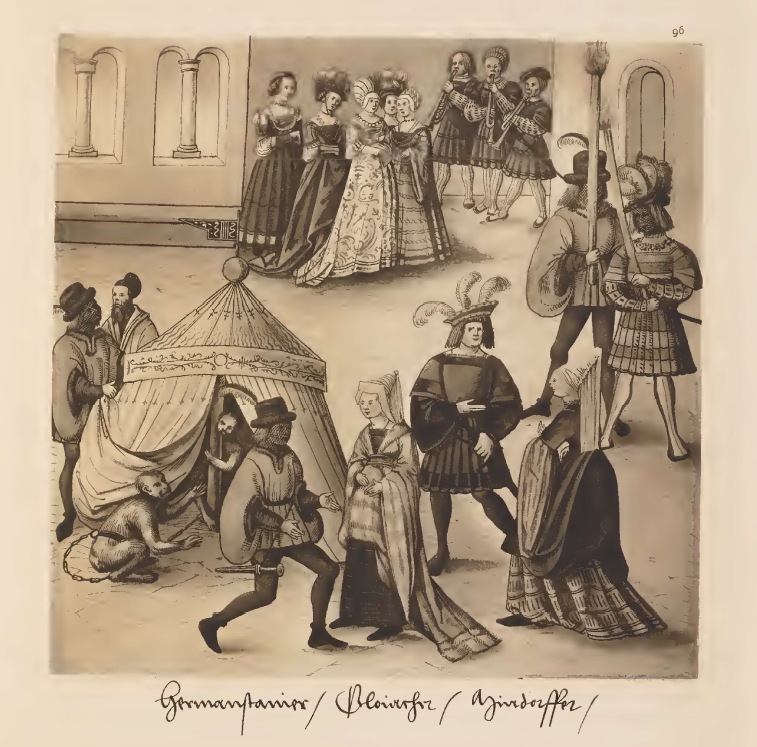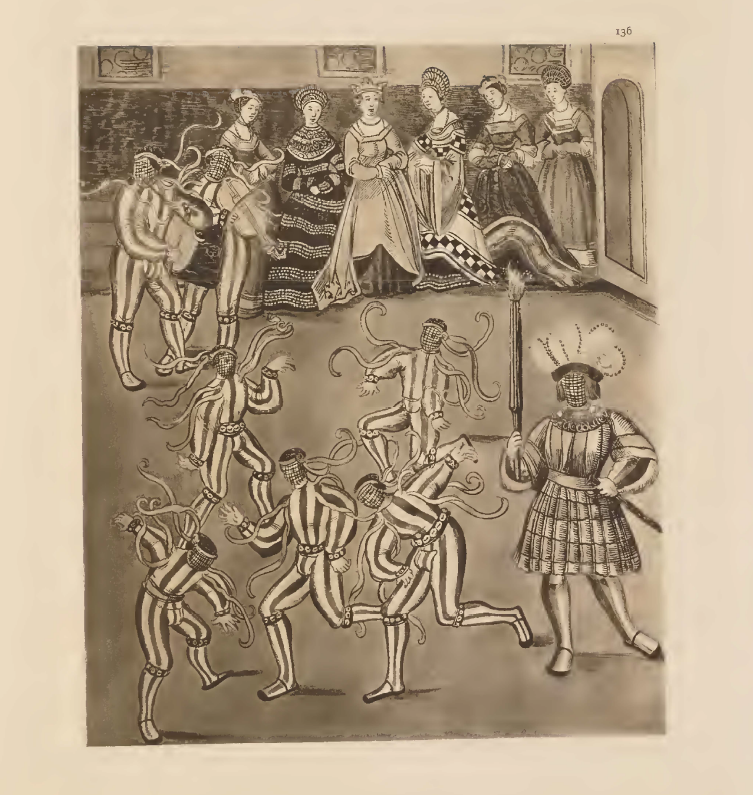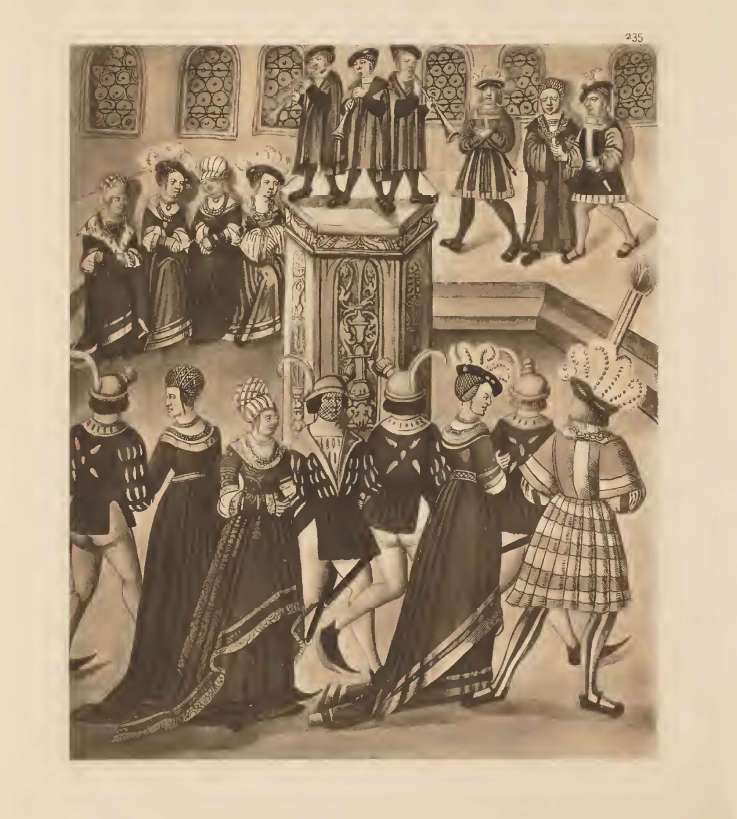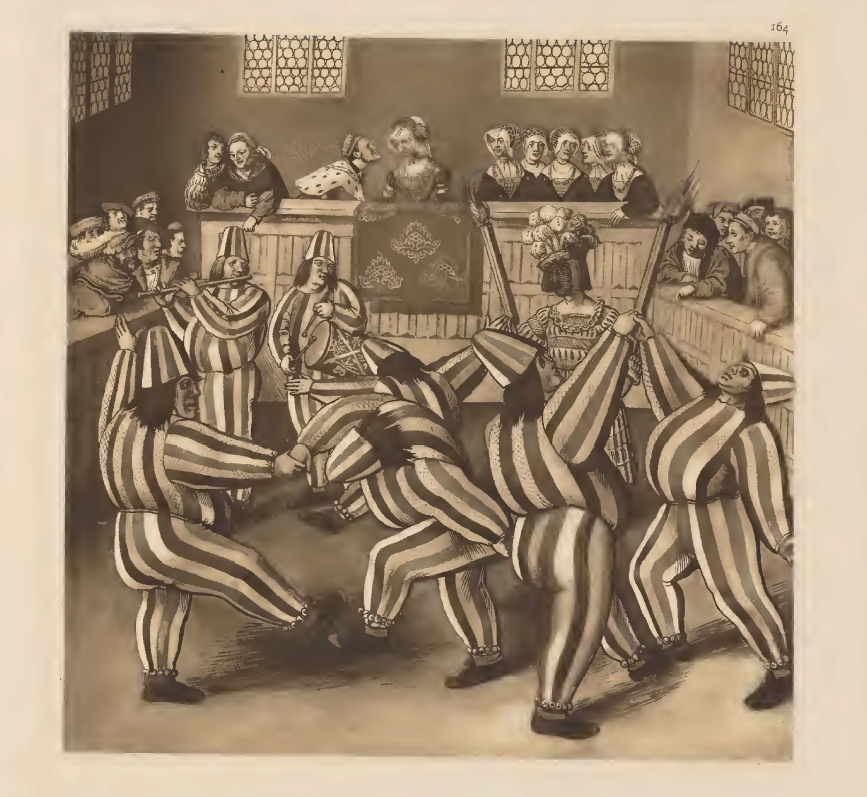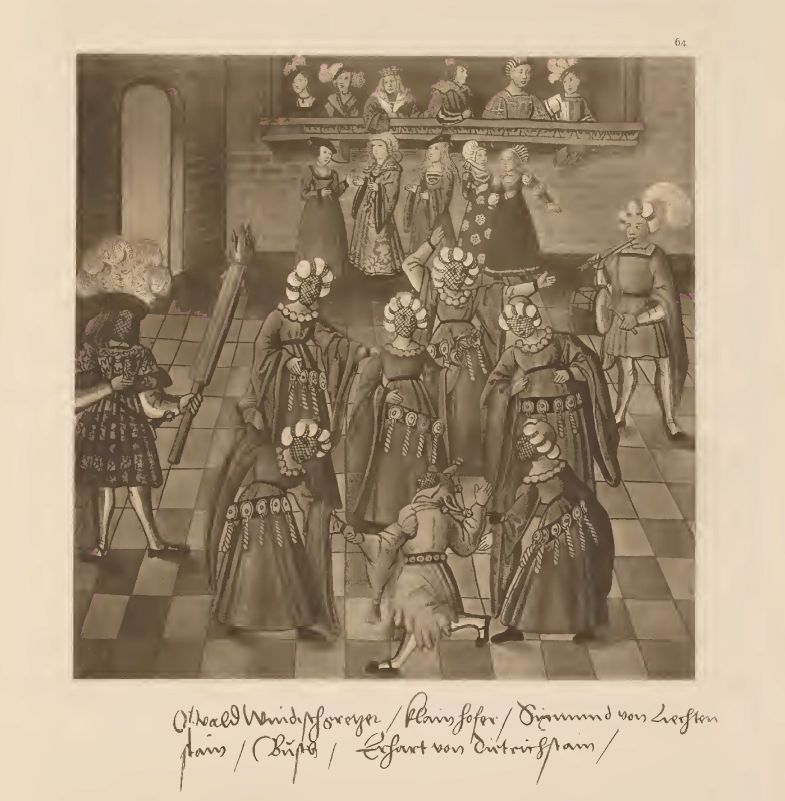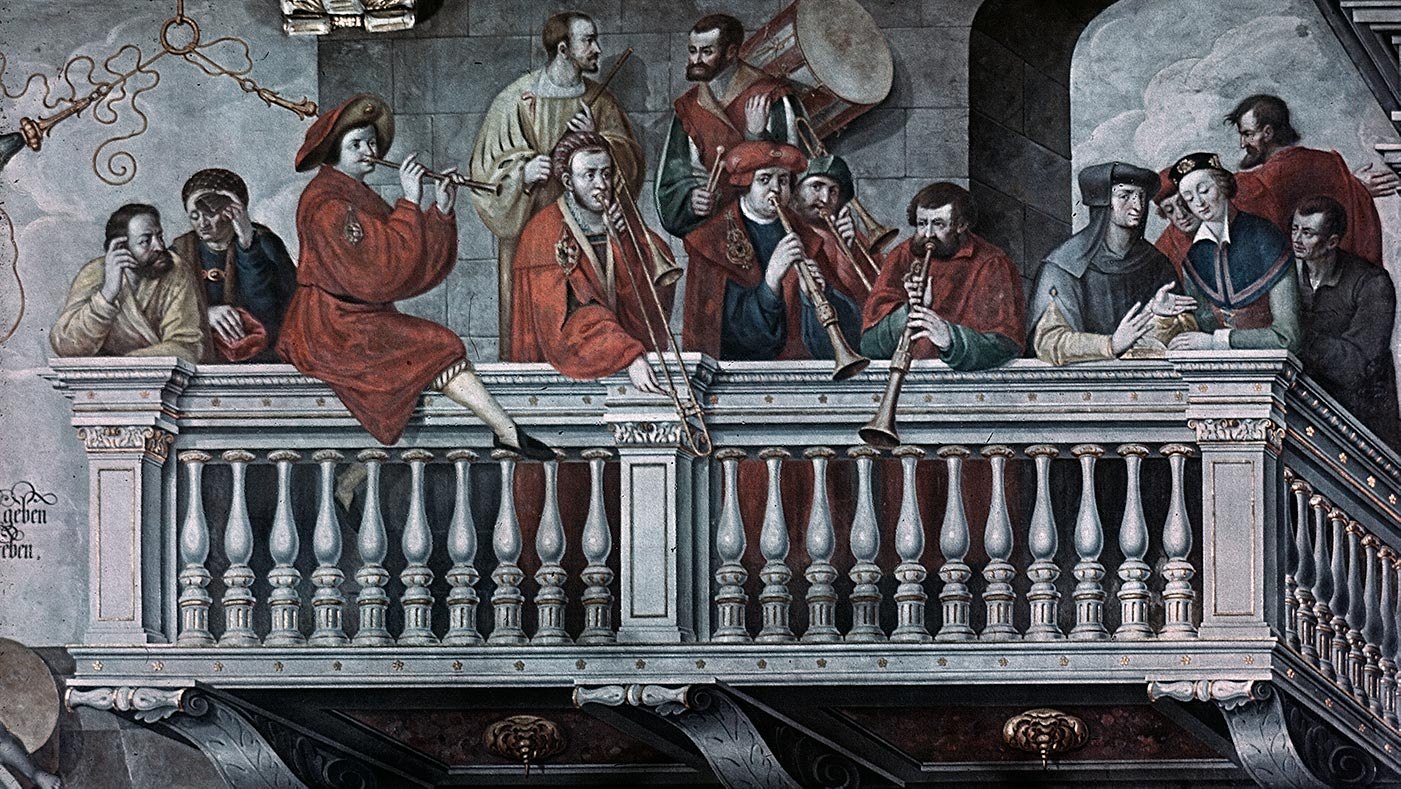Instruments for courtly and civic dancing
The musical resources of the cities were often noticeably enhanced by the visits of external musicians who regularly accompanied their royal and noble patrons upon their travels across the Empire for major political gatherings such as the Imperial diets. Though eye-witness accounts of their performances for dances in the cities often lack detail, they are nevertheless illuminating in the information they provide about the additional instruments that this court presence offered. References to the playing of ‘trumpeters’, for example, suggest a notable addition to civic resources, as at this time no German city possessed a trumpeter corps to match that of a royal or noble court. In Augsburg in 1496, Maximilian and his son Philip were reported to have danced around a fire with ‘some 10,000 people’, accompanied by ‘all the trumpeters’ there present.[67] Furthermore, at the Reichstag in Cologne in 1505, the series of dances that took place on 23 June (the last of which was described as ‘eynen Ronden dantz’) was accompanied by the princes’ trumpeters, of which there were around 34, 8 kettledrums, and two groups of Stadtpfeifer, from Cologne and Aachen.[68]
The presence of different groups of instrumentalists for one dance, as described in Cologne in 1505, was not unusual. In Donauwörth in 1500, for example, it was reported that, for a dance in celebration of the birth of the future Emperor Charles: ‘…hett K[ayserliche] M[ayestät] sein Trummeter, Kessel oder groz Baugen auf ain ortt verordnet, auf den andern die Zwerch pfeyffen vnd feld baugken, auf den dritten zingken vnd ander pfeyffer…’[69] (…His Imperial Majesty had ordered his trumpeter, kettle or large drum to one place, at the second, fifes and tabors, and at the third, cornetts and other pipers…). And at the wedding of Margrave Kasimir of Brandenburg and Susanna of Bavaria in Augsburg in 1518, trumpets again accompanied the dancing that evening with other instrumentalists: ‘alldo was zwayerley melody von zwayen Partheyen Baycken trummeter, die gar herrlich in ainander erhallen, mitsampt andern saitenspilen.’[70] (there were two types of melody from two parties of drummers and trumpeters, who sounded together quite magnificently, along with other music). Rainer Gstrein suggests that, while the term ‘Trummeter’ might refer to all kinds of loud instruments, the possibility remains that trumpeters may have played for the initial courtly dances – those with long, drawn-out steps —with other instrumentalists taking over for subsequent dances of faster tempo.[71]
Freydal represents many such instruments accompanying dances purportedly experienced by the King upon his quest to Mary of Burgundy:
However, there is very little documentary evidence of such performances taking place at the royal court. According to Anthoine de Lalaing, trumpets and drums played for dances during the visit of Philip of Burgundy in 1503 (» I. Kap. Jousts and dances for Philip), yet references to performances on other instruments are lacking, with one notable exception. The financial records of Maximilian’s court include a handful of payments to a piper and drummer for dances for Shrovetide between 1491 and 1493, and a further payment to them for various dances in 1496 (» Kap. Musicians for dance music). It is this combination of pipe and drum that is most frequently represented in Freydal, played by either a single musician or an ensemble of two (» Abb. Performance for dancing on pie and drum by two musicians; » Abb. Performance for Morisca dancing on pipe and drum by two musicians; » Abb. Performance for dancing on pipe and drum by one musician). While both Freydal and the financial records of the court link this combination of instruments with performances for mummeries (see also the account of the mummery in Cologne, 1486 » Kap. Mummerei, Moriskentanz), the ensemble seems to have achieved widespread popularity for all kinds of dances in both court and civic circles. In his Musica getutscht of 1511, Sebastian Virdung commented on the frequent use of pipe and drum for dances and weddings in France and the Netherlands.[72] Furthermore, it is these instruments that are shown playing for a courtly dance in Maximilian’s Fischereibuch (» Abb. A courtly dance accompanied by pipe and drum) and are also described as having performed for dances in Donauwörth in 1500 (see above).[73]
Though in the cities the Stadtpfeifer were regarded as possessing the highest status amongst resident musicians, there is also evidence of the employment of pipe and drum there for dancing. In the picture of the Augsburg patricians’ dance of 1500, for example (» Abb. Processional dance at Augsburg’s town hall), in the balcony up on high, the three Stadtpfeifer can be seen having a break from their playing, while a piper and drummer continue. In Nuremberg, a piper and drummer duo was employed throughout Maximilian’s reign, in addition to the resident Stadtpfeifer ensemble; a fresco that once adorned the walls of the city’s town hall shows the Stadtpfeifer playing, while in this case, it is the piper and drummer who rest (» Abb. The Nuremberg Stadtpfeifer ensemble, with a piper and a drummer).[74] The Schembartbücher that commemorate the Nuremberg carnival refer to the participation of the piper and drummer in the annual Shrovetide festivities, and namely for a dance in the streets that contained jumps and leaps and was performed by a group of citizens in vibrant and matching costumes.[75] Scholars such as Hoffmann-Axthelm and Gstrein suggest that the drum acted as a drone instrument beneath the pipe which created more elaborate music above. Such practices can be inferred from a later treatise, Thoinot Arbeau’s Orchesographie (1588), which considers the different roles of pipe and drum in the accompaniment of dance, the music for the fife being ‘composed to the player’s fancy’, while the drum, which was to mark the dancers’ steps, ‘blends [with other instruments], adding charm and serving as a bass and diapason to all harmonies.’[76]
[67] ‘Der ro. kinig und sein sun Philipps sind zü pfingsten 1496 hie gewessen. da hat man 10 füder holtz auff den Fronhoff gefiert, und nach ave Maria zeit ain himelsfeur gehebt, und hertzog Philipp und sein adel haben 3 mall um das feur dantzt, und sind da all trumether gewessen, und hand da ob 10000 menschen dantzt.’ in: Roth 1894, 71-72.
[68] Quoted in Kelber 2018, 128.
[69] Donauwörth Stadtarchiv, Johann Knebel, Stadtchronik (unpublished), fo.206v (cited in correspondence from Donauwörth Stadtarchiv).
[70] Quoted in Gstrein 1987, 86.
[71] Gstrein 1987, 88.
[72] ‘sunst ist noch ein Klein peucklin, das haben die frantzosen und niderlender ser zu den Schwegeln gebraucht, und sunderlich zu dantz, oder zu den hochzyten.’ (there is also a small kettledrum, which the French and Netherlanders have often used, above all for dancing or for weddings). Quoted in Gstrein 1987, 91.
[73] Gstrein 1987, 89; Schwindt 2018, 81-2.
[74] Hoffmann-Axthelm 1983, 96. See also Green 2011, 17.
[75] Sumberg 1941, 88.
[76] Translation from Sutton 1967, 39, 47. See also Brunner 1983, 54-5.
[1] Unterholzner 2015, 51; Wiesflecker 1971, 372-9.
[2] Annotations on the diary of Reinhart Noltz, Mayor of Worms, in: Boos 1893, 379. Translations of this and the following citations by Helen Coffey, unless stated otherwise.
[3] Neudecker and Preller 1851, 231.
[4] Hegel 1874, 732.
[5] Letter from Barbara Crivelli Stampi to Anna Maria Sforza, Duchess of Ferrara, 24 January 1494. Full transcript in Aigner 2005, 76-7.
[6] Guglielmo di Ebreo claimed that anyone who had studied the exercises in his treatise (1463) would be able to master the dance of any nation. See Nevile 2008, 13.
[7] See note 5.
[8] Amongst the earliest and most significant treatises of the fifteenth century are those prepared by dance masters of the Italian courts, which include Domenico da Piacenza’s De arte saltandi e choreas ducendii (c.1440-50), Antonio Cornazano’s Libro dell’arte del danzare (first version (now lost), 1455; second version, 1465) and Guglielmo Ebreo da Pesaro’s De Pratica Seu Arte Tripudii (1463). French and Burgundian dance practices and repertoire are conveyed in the basse danse manuscript associated with the Burgundian court of Maximilian’s daughter Margaret (now Bibliothèque Royale de Belgique MS 9085, c.1470-1501) and the related printed treatise L’Art et Instruction de Bien Dancer (published in Paris by Michel Toulouze, in or before 1496). For these, and later dance treatises, see Nevile 2004 and Heartz 1958-1963.
[9] See Heartz 1958-1963 and Heartz and Rader 2001a.
[10] See Heartz 1966; Heartz and Rader 2001b.
[11] Heartz 1958-1963, 290; Nevile 2004, 21.
[12] Sparti 1986, 347; Heartz and Rader 2001a.
[13] Aigner 2005, 45-54; Nevile 2004, 26-7. See also Sparti 1986 and Brainard 2001.
[14] Gombosi 1941, 294, 299-300; Heartz 1958-1963; Strohm 1993, 348, 553.
[15] Aigner 2005, 45-54; Nevile 2004, 26-7.
[16] Heartz 1966, 19. A significant use of the melody occurred in the Missa La Spagna by Henricus Isaac: see Mücke-Wiesenfeldt 2012.
[17] Nevile 2004, 2.
[18] Gombosi 1941, 298; Nevile 2004, 1-3.
[19] Gachard 1876, 305-306; for a German translation of the text, see Jungmann 2002, 65-66.
[20] Fucker 1505 (not paginated), quoted in Kelber 2018, 128.
[21] RI XIV,4,1 n. 15882, in: Regesta Imperii Online: http://www.regesta-imperii.de/id/1502-01-09_1_0_14_4_0_49_15882
[22] Kelber 2018, 124-7.
[23] Forthcoming in Regesta Imperii Online.
[24] Franke and Welzel 2013, 34-40.
[25] Leitner 1880-1882, IV.
[26] Leitner 1880-1882, LIII.
[27] Locke 2015, 115, 117-125; Franke and Welzel 2013; Welker 2013; Vignau-Wilberg 1999, 76.
[28] ‘zu frewden seinem volk und zu eren der frembden geest … ist [er] in sonderhait geren in der mumerey gegangen’. See Schultz 1888, 82-4; also Franke and Welzel 2013, 35 and Kelber 2019, 59.
[29] ‘At in aulicorum suorum nupciis conseuit frequenter conmutatis vestibus in gencium aliquarum ritum personatus coram populo saltare. Qua humanitate atque liberalitate sibi multum fauoris tum principum tum populi precipue soeminarum conciliauit.’ See Chmel 1838, 91 for a transcript of the original text; a German translation is presented in Ilgen 1891, 57-8 and quoted in Gstrein 1987, 94.
[30] Barozzi 1880, 216.
[31] Quoted in Kelber 2018, 123-4.
[32] Letter from Mercurino Arborio di Gattinara to Maximilian’s daughter Margaret, 22 November 1507, quoted in Kooperberg 1908, 363.
[33] Heartz and Rader 2001c; Sutton et al. 2001.
[34] Translation from Guthrie and Zorzi 1986, 19.
[35] See Kelber 2019, 66-67; also Schwindt 2018, 83.
[36] Meyer 1981, 64-66, Brainard 1984, Wetzel 1990; also Brinzing 1998, 133-134.
[37] Reicke and Reimann 1940, 439-440 and 496. An English translation of Dürer’s letter is in Fry 1913, 26; Beheim’s letter is translated into French in Meyer 1981, 63.
[38] See Habich 1911, 234; also Kelber 2019, 252.
[39] Translation adapted from Young 2013, 46. Also cited in » H. Kap. Eine süddeutsche Humanistenkorrespondenz (Markus Grassl), with further explanation.
[40] See Meyer 1981, 63-64, Polk 1992, 141-2.
[41] Translation adapted from Young 2013, 47.
[42] Young 2013, 46.
[43] See Heartz 1966, 19-20 and Polk 1992, 135, 139.
[44] Heartz 1966, 20-26.
[45] Habich 1911, 220. For another pictorial document of civic dancing and musicians, see » E. Kap. Musik im Dienst, und » Abb. Patrizierfest.
[46] See Polk 1992, 141; Brinzing 1998, 139-140; Kelber 2018, 136-8. Further on the MS, see » H. Kap. Schubinger und das Augsburger Liederbuch (Markus Grassl).
[47] For an overview of the restrictions see Brunner 1987.
[48] Stiefel 1949, 135.
[49] Brunner 1987, 58-63; Salmen 2001, 165.
[50] Quoted in Polk 1992, 11.
[51] Nuremberg Staatsarchiv, Rep.60a (Ratsverlässe), Nr.259, fol. 5v.
[52] Brunner 1987, 58.
[53] Salmen 1992, 23; see also Salmen 1995.
[54] Vogeleis 1979, 228.
[55] Salmen 2001, 174.
[56] Ernst 1945, 203.
[57] Schwindt 2018, 83-4.
[58] Gstrein 1987, 81.
[59] Polk 1992, 109. See also » E. Musiker in der Stadt (Reinhard Strohm).
[60] On surviving written sources related to Stadtpfeifer and their music (Maastricht fragment and others), see also Strohm 1992; Brown and Polk 2001, 127.
[61] Polk 2003, 98-104; see also, Heartz 1958-1963, 313-316; Heartz and Rader 2001b.
[62] Polk 1992, 161.
[63] Schünemann 1938, 53.
[64] See Welker 2013, 76.
[65] ‘so ließ die künigliche majestat derselben nacht ein tantz auf dem rathaus halten und mancherlei tentz auf welsche und niderlendische art üben und spil treiben, darin auch der kunig persönlich in einem schempart was.’ in: Hegel 1874, 732.
[66] Several references in the records of Nuremberg’s council refer to permission granted for use of the Stadtpfeifer, Stadtknechte and Schützen for the butchers’ annual Shrovetide dance. See, for example, Nuremberg Staatsarchiv, Rep.60b (Ratsbücher), Nr. 4, fol. 156r (1486), fol. 228v (1487), Nr. 5, fol. 4v (1488) and Nr. 6, fol. 2r (1493). For the development of and sources for the Schembartlauf, see Sumberg 1941 and Roller 1965.
[67] ‘Der ro. kinig und sein sun Philipps sind zü pfingsten 1496 hie gewessen. da hat man 10 füder holtz auff den Fronhoff gefiert, und nach ave Maria zeit ain himelsfeur gehebt, und hertzog Philipp und sein adel haben 3 mall um das feur dantzt, und sind da all trumether gewessen, und hand da ob 10000 menschen dantzt.’ in: Roth 1894, 71-72.
[68] Quoted in Kelber 2018, 128.
[69] Donauwörth Stadtarchiv, Johann Knebel, Stadtchronik (unpublished), fo.206v (cited in correspondence from Donauwörth Stadtarchiv).
[70] Quoted in Gstrein 1987, 86.
[71] Gstrein 1987, 88.
[72] ‘sunst ist noch ein Klein peucklin, das haben die frantzosen und niderlender ser zu den Schwegeln gebraucht, und sunderlich zu dantz, oder zu den hochzyten.’ (there is also a small kettledrum, which the French and Netherlanders have often used, above all for dancing or for weddings). Quoted in Gstrein 1987, 91.
[73] Gstrein 1987, 89; Schwindt 2018, 81-2.
[74] Hoffmann-Axthelm 1983, 96. See also Green 2011, 17.
[75] Sumberg 1941, 88.
[76] Translation from Sutton 1967, 39, 47. See also Brunner 1983, 54-5.
